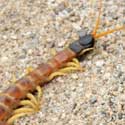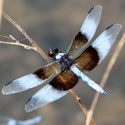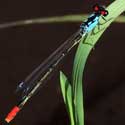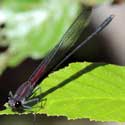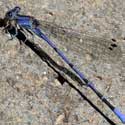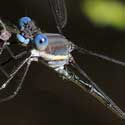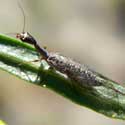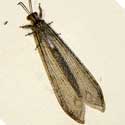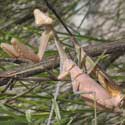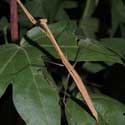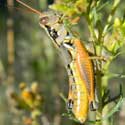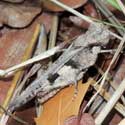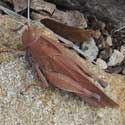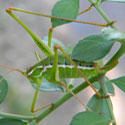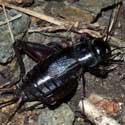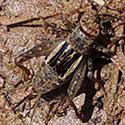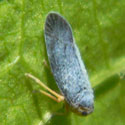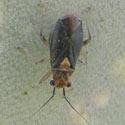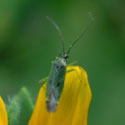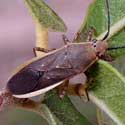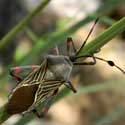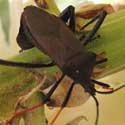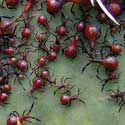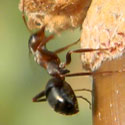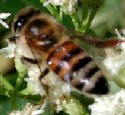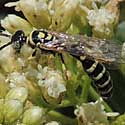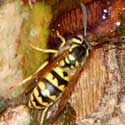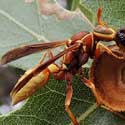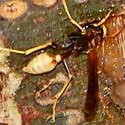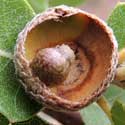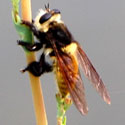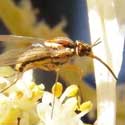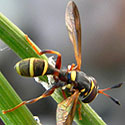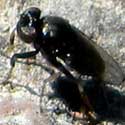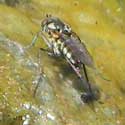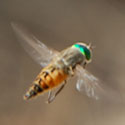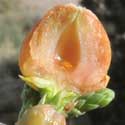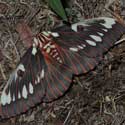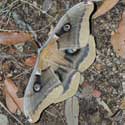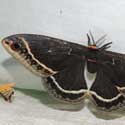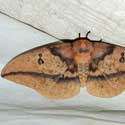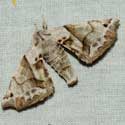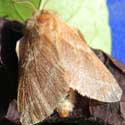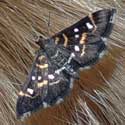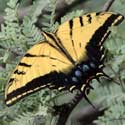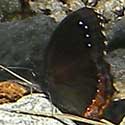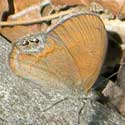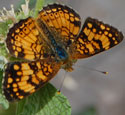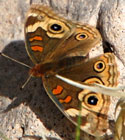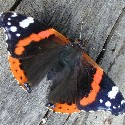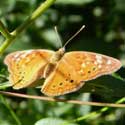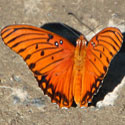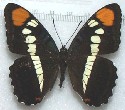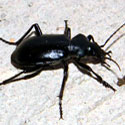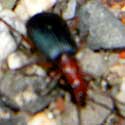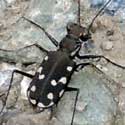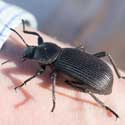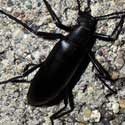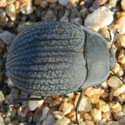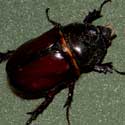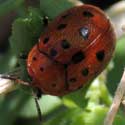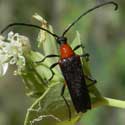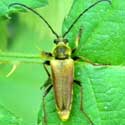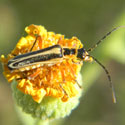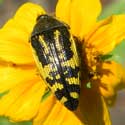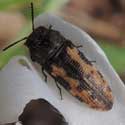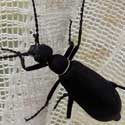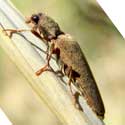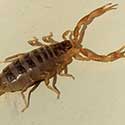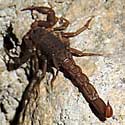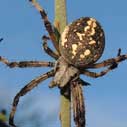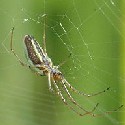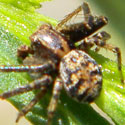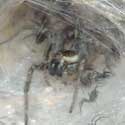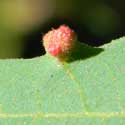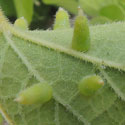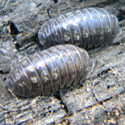Giant Red-headed Centipede
One pair of legs per segment. Large and fast moving. Variety of color patterns. More ...
Widow Skimmer
Males with bluish-white patches at mid-wing and dark brown on basal third of all four wings. More ...
Painted Damsel
Dainty version of dragonfly moves slowly about close to slow waters. Males vividly marked. More ...
Canyon Rubyspot
Patch or ruby red is at the bases of the four wings. (Yes dragonflies and damsels have two pairs of wings.) More ...
California Dancer
Male is sky blue with black markings. Frequents slow riparian streams. More ...
Great Spreadwing
But this damselfly, an exception, holds its wings horizontal, spread parallel to surface. Great Spreadwing has a yellow stripe on sides of thorax. More ...
Snakefly
Curious insect with an elongated prothorax (neck) and finely veined, membranous wings. More ...
Giant Ant-Lion
Large, delicate-winged, insects come readily to electric light. Wings have fine network of veins. Antennae elbowed. More ...
Arizona Mantis
Robust mantis capable of catching big prey. The female might eat her mate! More ...
Wingless Mantis
Slender praying mantis, light brown in color, and without wings as an adult female. More ...
Arid Lands Grasshopper
Well concealed grasshopper feeds often within shrubs. Yellow and gray with black markings. Flies well, More ...
Three-banded Grasshopper
Three dark bands on each lateral surface distinguish this pale gray hopper. More ...
Oak Leaf Grasshopper
Looks so much like a dead oak leaf that predators ignore this insect. More ...
Short-winged Katydid
Bright green with white lines/marks. Long hair-like antennae and strong jumping legs. More ...
Field Cricket
Nocturnal insect famous for males' chirping. A number of species possible in our riparian woodlands. More ...
Ground Cricket
Small, secretive crickets that inhabit cavities near the soil surface. More ...
Yellow-headed Hopper
No common name for this small blue hopper with a distinct yellow head. Only about 2½mm long. Jumps and flies. More ...
Agave Plant Bug
Found exclusively on agave plants where common. Causes oozing spots on leaves and stems. More ...
Sunflower Plant Bug
There are dozens of green plant bug species. This one was on AZ sunflower. More ...
Catorhintha
Brown bug about 11mm, with a marginal band of cream-white. Can be found on variety of plants. More ...
Giant Mequite Bug
Armed with multiple defenses: toxic sprays, intimidating size, and sharp spines. More ...
Giant Agave Bug
Very large, mostly black bug, with orange tips of legs and antennae. Hind legs with leaf-like expansions. More ...
Cactus Bugs
The young (nymphs) cluster together and are red and
green. Feed on prickly pears and other cacti. More
...
Wood Ant
Ubiquitous ants in woodlands and shrublands foraging on trees and foliage. Sprays formic acid in defense. More ...
Honey Bee
Golden brown bee with black abdominal bands. Rather
large and slow compared to most bees. Overly common. More
...
Myzinum Wasp
Males are long and slender with bold yellow and black bands. False stinger at abdomen tip. More ...
Western Yellowjacket
Sharply marked yellow and black hornet that frequents picnics and other food supplies. Yellow ring around eye. Distinct abdomen marks. More ...
Golden Paper Wasp
Brick red thorax and gold yellow abdomen. Unless you disturb their nest these likely won't sting. More ...
Comanche Paper Wasp
Yellow abdomen attached by very narrow 'waste'. Thorax and wings coffee-brown. Comes to flowers and builds paper nests. More ...
Gall Wasp
The wasp which caused this plant growth on an oak acorn cup is smaller than a pinhead. More ...
Bumblebee Mimic
This audacious fly looks like a bee and then hunts bees to eat. Bold, fuzzy black, yellow and orange. More ...
Flower Fly
Many, many kinds of flies visit flowers for nectar and many are important pollinators. More ...
Thick-headed Fly
Looks like a scary wasp but it's harmless. Instead it's a curious fly in disguise. More ...
Black Fly
Small black flies that usually live near flowing water. Occasionally bite. More ...
Dance Fly
Dance flies perform their footwork on the muddy edges of streams and ponds. Quite small as adults, the worm-like larvae live in clumps of dying algae. More ...
Deer Fly
Robust, fast flying flies the most common about twice the size of a house fly. Tend to bite hikers about the ankles. More ...
Juniper Bud Gall
The small orange larva at the center belongs to a gall midge, a minute fly. The galls look a lot like juniper berries. More ...
Splendid Royal Moth
Fantastic shades and patterns of charcoal, brick red and white. Very large night flyer in borderland canyons. More ...
Polyphemus Moth
Big eyespots with blue eye shadow on the hind wings. Another smaller pair in forewings. Flies at night. Huge size. More ...
Calleta Silk Moth
This dark-colored silk moth is smaller than the other giants. A whitish band bisects the wings. More ...
Imperial Moth
Another huge moth; yellow mottled with brown. Rarely seen except at lights during the summer monsoons. More ...
Baccharis Moth
During the day this night flyer sits perfectly still like a piece of sycamore bark. More ...
SW Tent Caterpillar
Moth is nocturnal and rarely seen. Larvae make conspicuous tents in willows and other trees. More ...
Diathrausta Moth
There are thousands of species of small moths - this one is boldly marked. See them at electric lights. More ...
Silver-spotted Skipper
Large as far as skippers go. White-silver patch on hindwing. Lands with wings partly closed. More ...
Two-tailed Swallowtail
Very large yellow butterflies with black and blue markings. Often seen patrolling up and down sycamore-lined canyons. More ...
Red-bordered Satyr
Flies among trees near to the ground and not to flowers. Perches with wings folded above. Red and lavender markings along edge of hind wing. More ...
Nabokov's Satyr
Flies close to ground between trees. Brown often conceals against dead leaves and bare soil. Pearly splotch on hindwing margin. More ...
Mourning Cloak
Cream-colored border around a deep purple-brown
center. Likely to be seen flying on warm days through winter and early spring near willow
trees, More
...
Mylitta Crescent
Small, bright orange butterfly marked with intricate checker pattern. Avid flower visitor. More ...
Buckeye
Ground color is rich brown. Blue-centered spots along wing margins. Often lands upon damp soil in sunshine. More ...
Red Admiral
Dark brown butterfly with red-orange submarginal
bands. Mostly avoids flowers preferring sap, carrion or dung. More
...
Hackberry Emperor
Golden brown butterfly with black and white spots. Eye-spots below with blue centers. More ...
Arizona Red Spotted Purple
Iridescent blue-purple on black with row of lighter spots along outer margins. No tails. Flies along streams near willows. More ...
Gulf Fritillary
Bright, showy orange butterfly with black vein marks. Also shows up in towns near passion flowers are cultivated. More ...
Arizona Sister
Very dark background accented by bold white diagonal arising from orange spot in forewing. Visits sap and dung but not flowers. More ...
Spring Azure
Bright blue, nickel-sized butterfly. Beneath is silvery gray marked with slightly grayer marks. More ...
Marine Blue
Lavender-blue and quite small. Pair of small high spots near posterior margin. Gathers abundantly at damp soil. More ...
Ground Beetle
Large, fast moving, glossy black beetle. Can pinch if mishandled or release a smelly liquid. Eats insects fallen under outdoor lighting. More ...
Bombardier Beetle
Fast moving black and fire orange. Found beneath rocks near flowing water. More ...
Tiger Beetle
Long running legs, big alert eyes, fast folding wings, and a pair of deadly mandibles. Sandy areas near water. More ...
Pinacate Beetle
Large, slow moving and well armoured. Lifts tip of abdomen in air if disturbed and release bad odor. More ...
Pinacate #2
There are several similar-looking Eleodes beetles but all are slow-moving and black. More ...
Darkling Beetle
Tough little tanks that amble along ground. About 10 mm long. More ...
Ox Beetle
Large, lumbering beetles, brown to nearly black. A couple of species, some males with horns. More ...
Morning Glory Tortoise
Orange-red beetle spotted with black and with a turtle-like shell. Feeds on morning glory leaves. More ...
Flower Longhorn
Many kinds of colorful cerambycids. Long antennae, first wings hardened and concealing flight wings. More ...
Golden Flower Longhorn
Elongate elyra and pronotum clothed in golden hairs. Often seen on composite flowers. More ...
Soldier Beetle
The elytra are soft and colorful. Frequent on flowers eating the pollen. More ...
Flower Buprestid
Glossy and brightly colored beetles sit on flowers. Many kinds with yellow, red or green markings on black. More ...
Flower Buprestid #2
Glossy beetle marked with mustard yellow and black. Sits on flowers. Many kinds with yellow, red or green markings on black. More ...
Black Blister Beetle
All satin black except for a white band on thorax. Clumsy moving and with soft wing covers. More ...
Click Beetle
Elongated beetles with usu. tapered posterior and sharp corners to pronotum. "Clicks" to right self when positioned on back. More ...
Stripe-tailed Scorpion
Rather heavily built. Stripes on underside of tail. Hides under rocks or dry dung. More ...
Small Brown Scorpion
Hides under rocks by day. A uv light is easiest way to find at night. More ...
Spotted Orb Weaver
Large spider sits at center of orb by night, but ensconsed by daylight. More ...
Long-Jawed Spider
Orb webs are spun just over the water usually with
the plane parallel to ground. Long slender body. Chelicerae long. More
...
Ground Crab Spider
Well camouflaged spiders that hunt without a web by sitting close to where prey might come. Tend to crawl sideways. More ...
Funnel Wolf Spider
Unlike most wolf spiders this one uses a web to catch prey. But like wolf spiders this species cares for her young. More ...
Walnut-Leaf Gall-Mite
Inside the red blister are many minute mites which direct the plant's growth. More ...
Finger-Gall Mite
Inside these elongated galls on the underside of hackberry leaves are minute mites which direct the plant's growth. More ...
Common Pill-Bug
Not a bug or insect at all! These are crustaceans,
kin to shrimp and crabs. Curls into tight ball. Lives among damp leaves and under logs.
More
...
